An Intranet Manager’s job can be a constant balancing act.
You’re the one tasked with ensuring user adoption, encouraging collaboration and creating a site that fulfils the unique requirements of your business. There’s content to post, permissions to manage, questions to field. Plus, there’s always today’s crisis: getting an urgent message out, fixing a broken widget, updating the CEO’s profile picture; whatever it may be.
Given the demands – often coming from various individuals, departments and locations – you need all the support you can get to keep things ticking over.
To make the day-to-day lives of intranet managers everywhere just a little bit easier, we’ve compiled 10 top tips to help you with some of the biggest intranet headaches we come across every day. Here are some quick win cheats, designed to do the hard work for you.
1. Getting users to update their profiles
Your People Directory is at the very heart of a successful social intranet. It connects employees across the boundaries of department, office location or even time zone to ensure a truly collaborative culture. For remote workers or those out on the road, it can be a life line.
However, realizing the true potential of any intranet is dependent on those user profiles being completed and up to date: usually with a photo, job title and department information, correct phone number, skills and interests. As many an intranet manager will tell you, getting that information should be easy in theory – but is often extremely frustrating in practice.
Business Scenario:
“I spent two weeks trying to find a German speaker to translate on a potential new deal for us. Turns out, James downstairs is fluent. However, the information wasn’t on his intranet user profile, and now the chance is gone.”

Quick wins:
- Make intranet profiles a part of the new starter onboarding process. Consider assigning the task of photographing your newbie internally to ensure you capture a profile picture also. If it’s one of the ‘must-dos’ for their first week in the job, you’ve a better chance of it being completed.
- Utilize integration functionality within your intranet to populate profiles automatically and seamlessly from different third-party directory sources, such as Active Directory, Azure Directory or by using a Profile Sync API. If your employees want to be paid, they’ll give their information to payroll; you can choose to automatically lift selected fields of that data into your intranet. Best of all, profiles will automatically update whenever data is changed – making it easy to keep profiles up-to-date.
- Make it worth their while: use gamification, an event or an incentive to encourage existing employees to participate in updating their profiles. A great example of this was undertaken by MHS Homes as part of their intranet launch:
“We ran a competition with this series of posters, each one simply showing a silhouette of a staff member and a question about that person. The reader then had to search the bios to find out who the question related to.
“But here’s the thing: they couldn’t enter the competition unless they had filled in their own biography!” (David Giblin, MHS Homes).

2. Getting the right content to people
Pushing the right content to the right people at the right time is one of the greatest internal communications challenges we face, particularly in an age of digital noise. What’s more, digitally-savvy users are increasingly demanding a personalized user experience from their workplace technology.
How do you manage the process accommodating ever changing business, and individual, demands?
Business Scenario:
“Every time I go to the intranet, it’s the same old content. It doesn’t even really help me in my job role, so I just don’t bother with it anymore.”
Quick wins:
- Tailored homepages offer a unique way to personalize the intranet experience. For example, creating a New Starter homepage with content specific to new employees, such as FAQs, key policy documents or a welcome video, which displays for a defined period at the start of employment. Alternatively, department-specific homepages can display widgets or dashboards relevant to those roles – such as sales targets, or service desk dashboards.
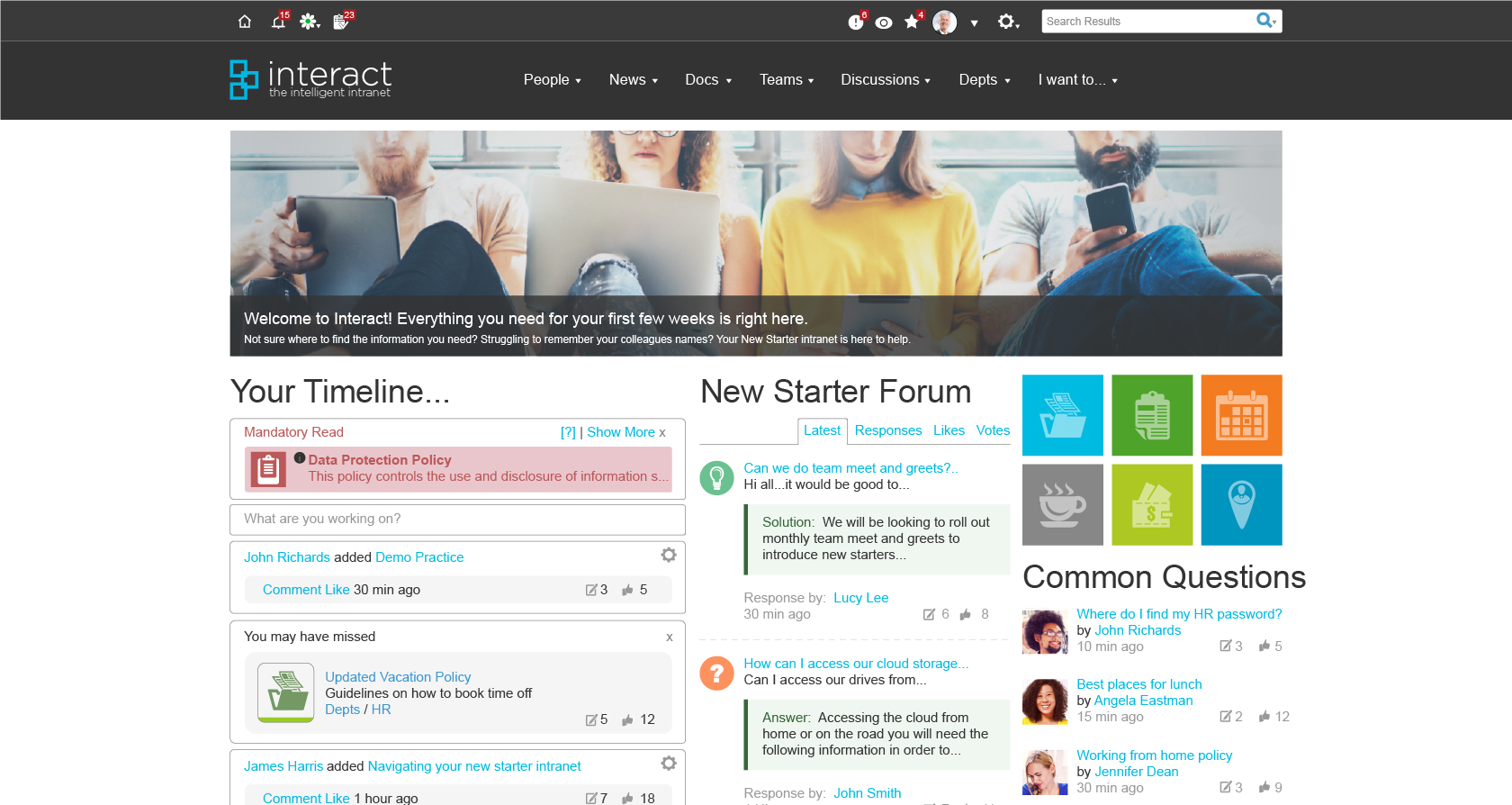
(Example new starter homepage on Interact.)
- Intelligent suggestions for content: does your intranet do the hard work for you when it comes to learning about and understanding your employees?
Using a powerful intelligence mechanism that learns from previous interactions and user behaviors, Interact Suggests presents an individually tailored ‘results’ list of new content to people, helping them to discover new knowledge that may otherwise have been missed. All you need to do is add the widget in a prominent place. Problem solved!
3. Getting senior management to contribute
Securing buy-in from those operating at the top of your business can make a huge difference to how your employees perceive, engage with, and use, the intranet. Ideally, you want managers to lead by example: posting blogs or content, responding to discussions on the forums, giving recognition to employees or teams.
However, the reality is that many senior members of management have significant time constraints and different priorities. Their contributions may be sparse at best, and often if they do contribute, they’re quick-fire communications: short, without images or other media.
Business Scenario:
“I work on the shop floor and don’t have visibility of management in our head office. I don’t get to hear what’s happening with my organization or feel like I have access to those at the top to make my voice heard. It’s making me feel disengaged with the business.”
Quick wins:
- Ghost write on the behalf of senior management, or put this task to your internal comms department. This speeds along the process, improves the quality of content and ensures higher volumes of content from those at the top.
- Use video contributions instead. Getting your CEO to video their thanks, news or feedback is not only quicker for them, but may also result in higher levels of engagement from staff.
5. Creating engaging, dynamic and interactive content
When you’re looking to drive engagement with your intranet, hosting stacks of dry HR policy documents simply won’t cut it. But if you’re the one charged with producing content, how can you keep up with the demand while ensuring it remains engaging, dynamic and appeals to your employees?
Business Scenario:
“Our intranet has become a dumping ground for essential business information, policies and documents. I know to go there when I want to access our latest privacy policy, but aside from that, there’s nothing there that interests me.”
Quick wins:
- Give your intranet to your employees: selecting an intranet solution that is easy for non-technical users to navigate and create content on is key. Ask your employees for contributions on blogs, forums and team areas; allow for both business and non-business content to create a common culture where employees feel happy and confident contributing. We explore more about getting ideas and contributions from employees in our recent blog.
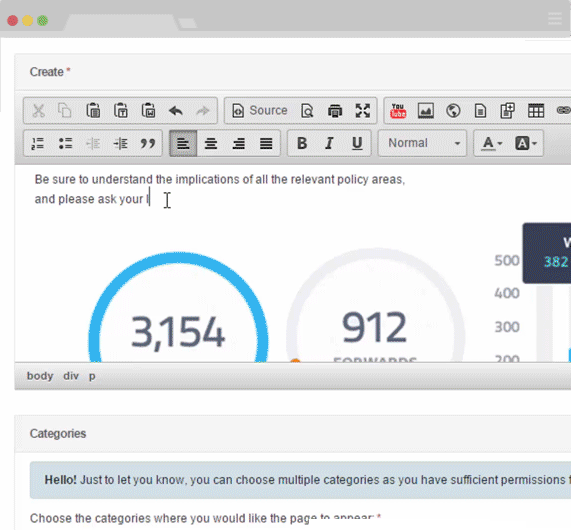
(Interact CMS uses a ‘WYSIWYG’ editor that is simple and easy to use, enabling even non-technical users to easily and quickly contribute content.)
- Utilize intuitive social tools that put the power of managing and pushing content into the hands of users, rather than intranet managers alone.
For example, your users can @mention an individual, document or piece of content when writing on the intranet – alerting people with a vested interest that there is something for them to read. #tags make for a simple way to group related information, while a social timeline on your homepage ensures there is continually refreshed, dynamic content. Best of all, these are tools your employees use on a daily basis in their own lives – taking the pressure off you as intranet manager.
Need more inspiration? Why not check out our ‘Internal Comms Hacks’ blog for some creative ideas to engage your employees.
6. Moving business processes online
Intranets, as we know, are more than a simple communication tool. Thanks to the inclusion of many workflows, forms and administrative functions, they are a powerfully efficient way to streamline and automate many business processes – whether that be submitting expenses, booking annual leave or completing internal training.
However, as Intranet Manager you’ll often find yourself stuck with the responsibility of creating and managing workflows or forms for various departments, placing a considerable burden on what limited time and resource you have available. The danger is, without effective, well-built forms and a standardized process, many employees will revert to the devil they know – complicating your business process further.
Business Scenarios:
“The intranet form was missing an important field, so we need to rebuild it or get everyone to send the additional information separately via email.”
Quick wins:
- Easy to build forms, accompanied with a lunch-and-learn or workshop, can upskill middle managers to take ownership for creating and managing their own workflows. Interact’s simple ‘drag and drop’ form interface empowers all users, regardless of their technical expertise, to quickly and efficiently add elements such as text boxes, drop down menus and option buttons to your forms. Simple!
- Utilize automation within your intranet. Be notified by email when forms are completed and run reports in Excel to audit all types of a form submitted. Decision makers can be alerted when they need to complete an action, or if a form is waiting to be completed everyone involved can see who it’s sat with.
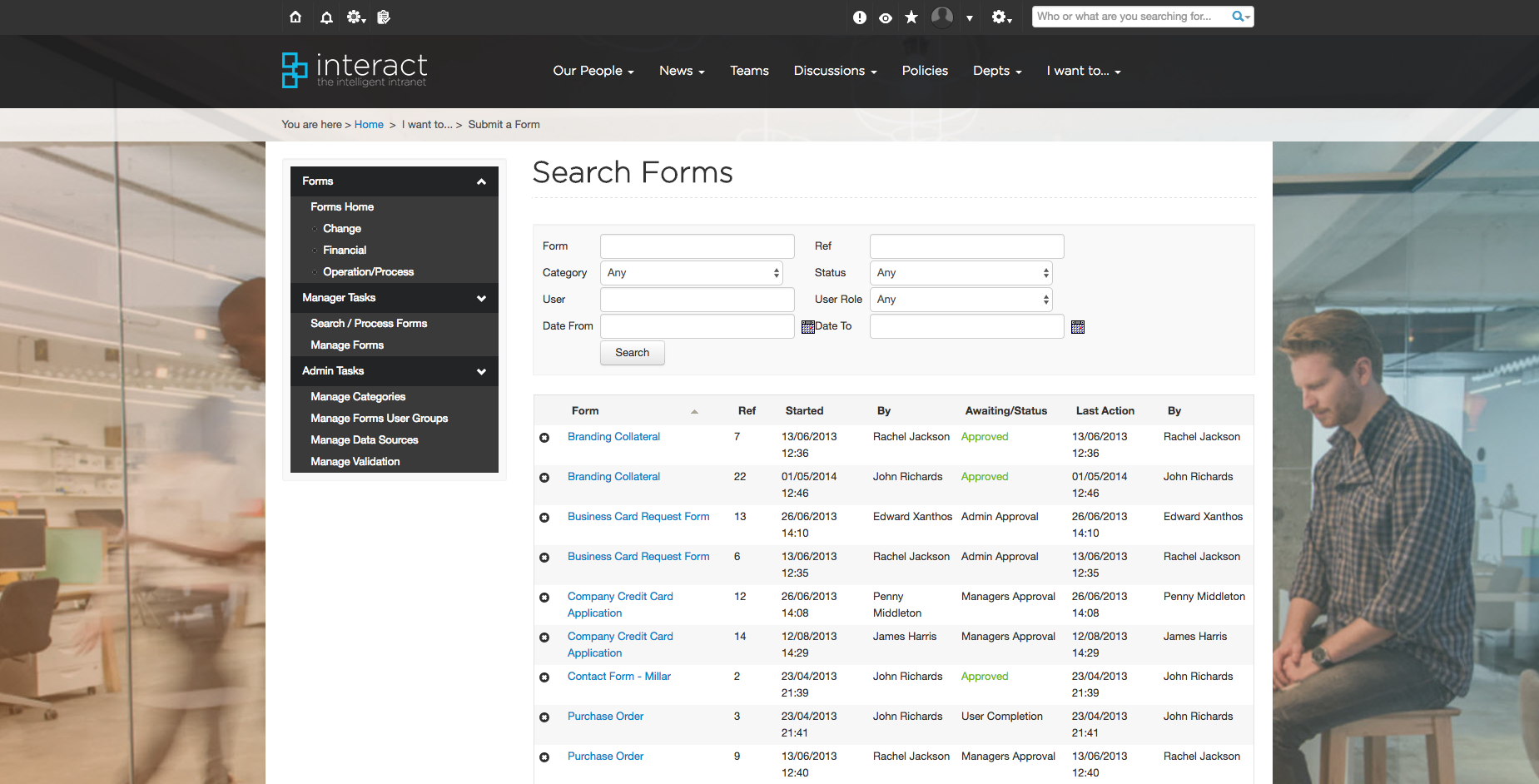
(Interact’s Forms management tool gives you an accessible overview of all your forms, their current status and the last action taken.)
7. Encouraging group collaboration – without creating more workload
With staff spread globally, working remotely and accessing your business across a multitude of devices, empowering your employees to collaborate effectively can be a challenge. Having a centralized and accessible digital workplace is becoming more and more imperative.
However, there’s always the risk that adding an intranet to the technology stack will just complicate things further – spreading information and projects over yet more platforms, rather than simplifying it.
Business Scenario:
“We’re working on a project but the process is all over the place. Some communication takes place via email, with attachments, some on our ESN. We’ve got documents in our Cloud storage, some on the intranet, some on individual PCs. And we’re losing track of versions and where we’re up to.”
Quick wins:
- Integrating your intranet with your cloud storage platforms, business critical applications and SharePoint online in Office365 brings together those individual systems, rather than pushing them further apart. Users can access and work on documents from a centralized location, bringing documents directly into intranet posts by @mentioning them for ease of access.
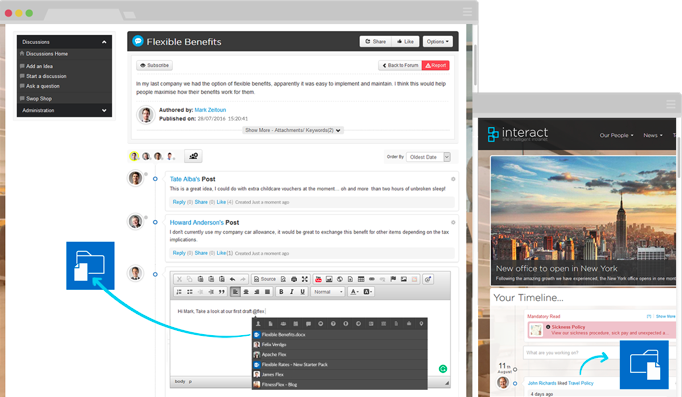
- Use dedicated Team areas for collaboration – whether for individual departments, specific projects or common interests. Each area can have individual pages and content areas, including calendars, forums, galleries, a timeline and more. Upskilling your users in the capabilities of these functions will increase adoption and engagement with your intranet as a business-critical application and streamline every day processes – making it more valuable.
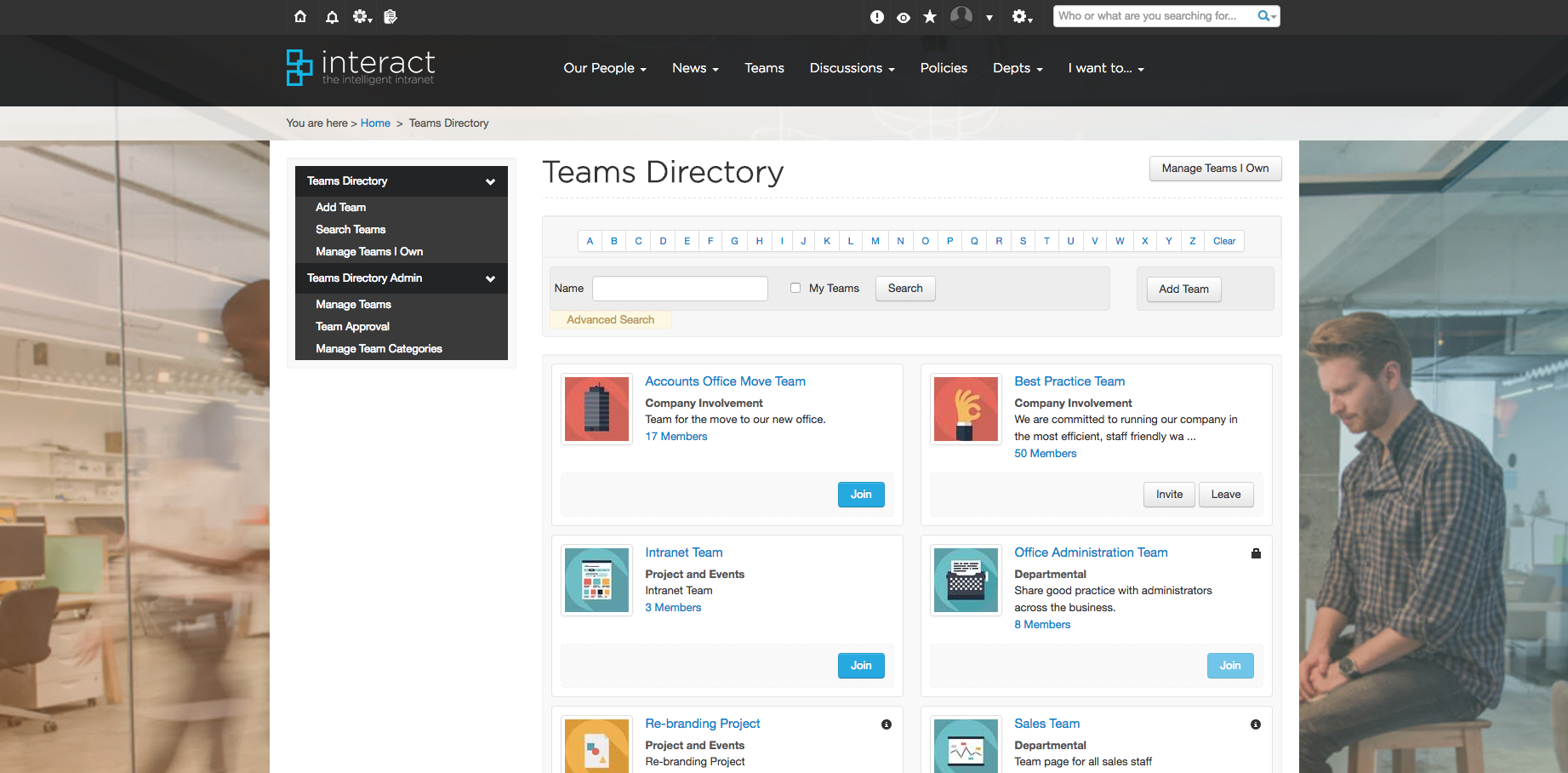
8. Knowing what information is missing
It’s your job to plug any content gaps on your intranet and know what people are looking for. Missing or poorly tagged content that isn’t easily accessible leads to frustration, reduces productivity and ultimately damages the reputation of – and engagement with – your intranet.
However, getting people to tell you what information is missing can be a huge challenge – particularly in larger or dispersed organizations. You can’t single-handedly test every viable search, so how do you ensure your intranet continues to be to go-to business solution it should be?
Business Scenario:
“All I want is to find how I can start a company pension, but this wasn’t in the HR area of the intranet. It’s just easier to ring Pat in HR and ask her. Why should I use the intranet if I can’t find the information I need on it?”
Quick wins:
- Use tagging and Best Bets to map out your content effectively, ensuring your employees find what they’re looking for. By spending an extra 2 minutes assigning appropriate tags when producing content, you save yourself hours of time and frustration further down the line.
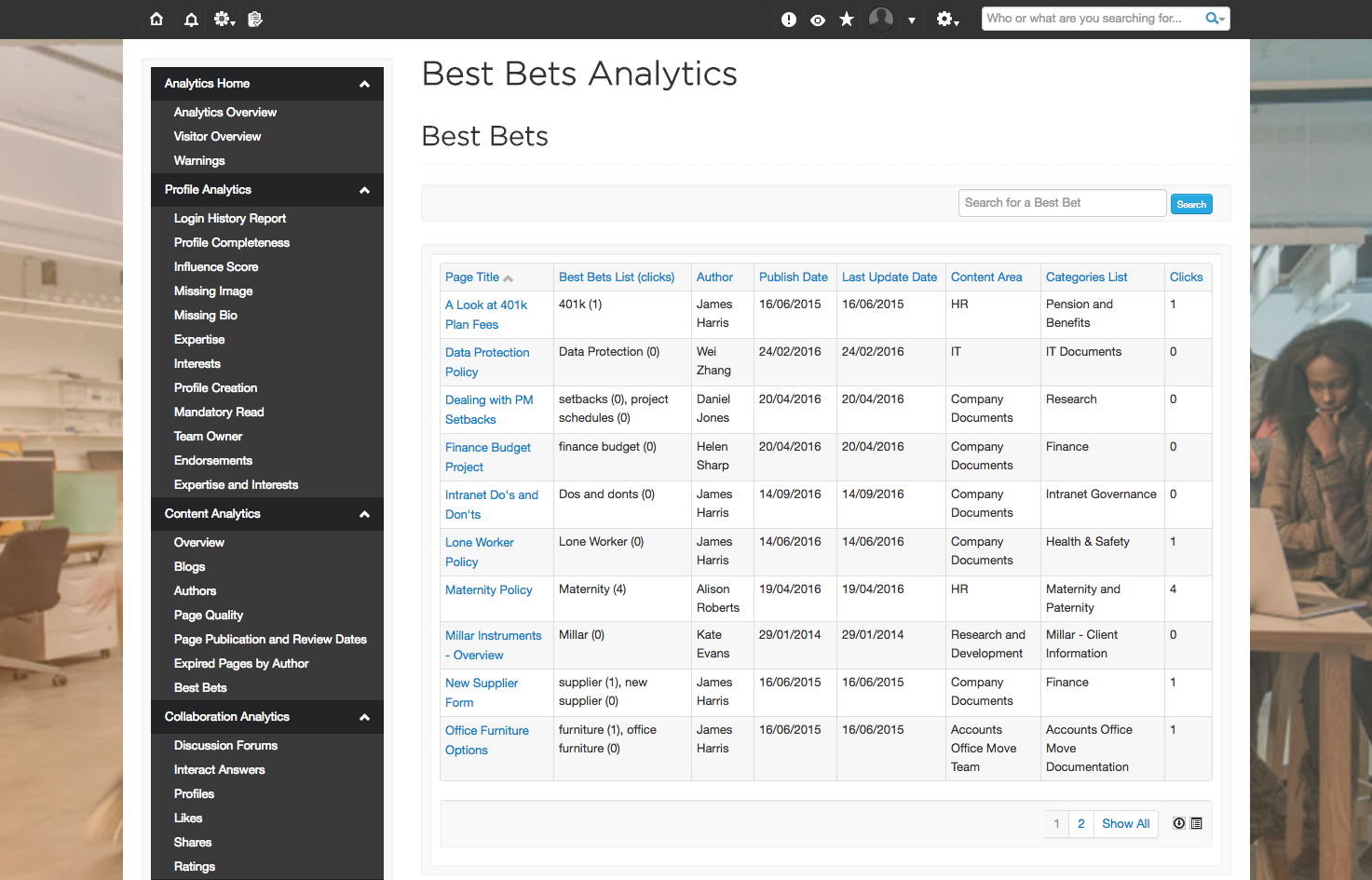
- Use analytics features such as Failure to Find or Searches with Zero results reports, you can quickly identify what people are looking for and have been unable to find. Responding to these by assigning Best Bets or creating content to match those search phrases plugs the gap, ensuring continued trust and engagement from employees.
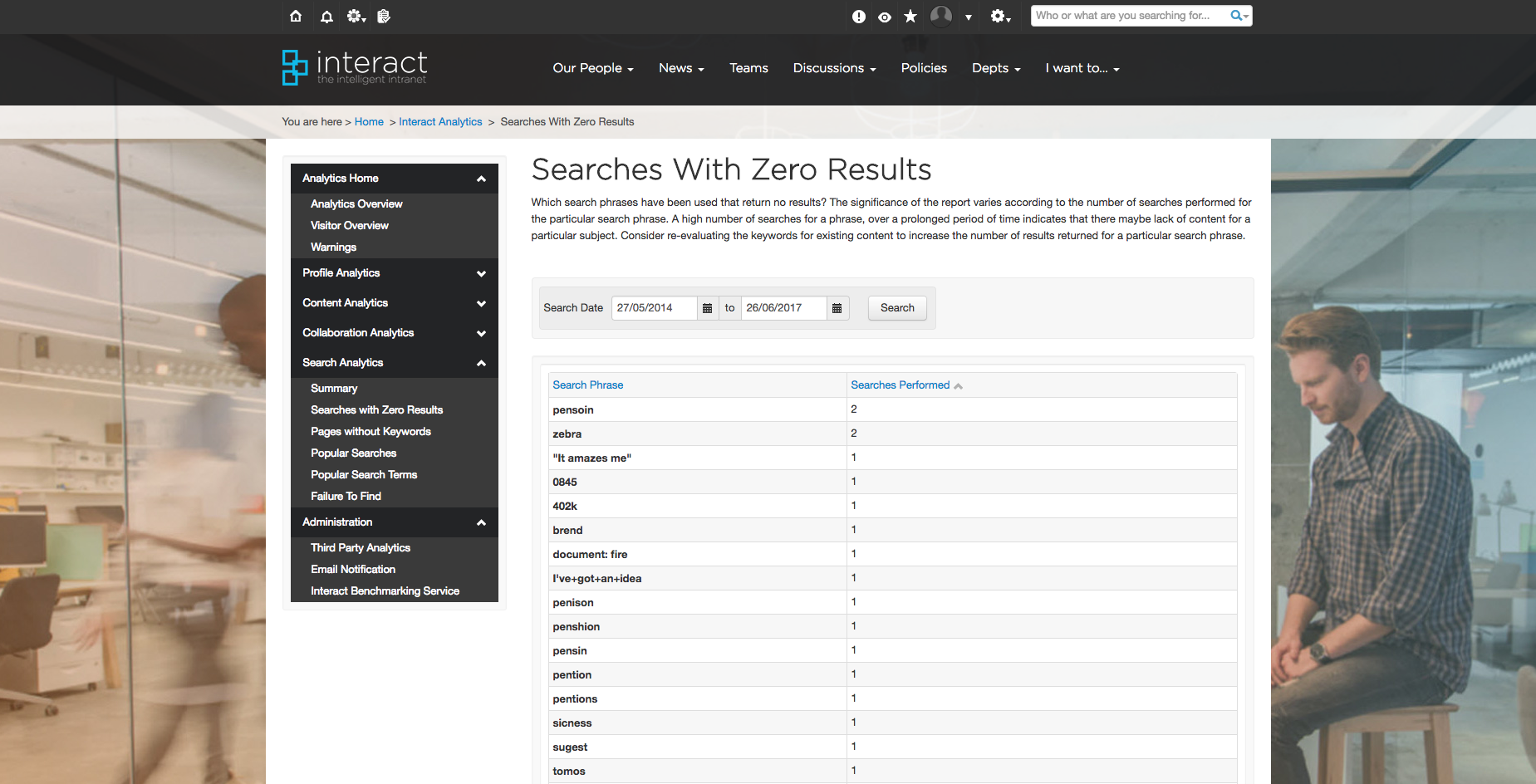
(The ‘searches with zero results’ report on Interact shows you quickly and easily what your people are looking for, allowing you to intuitively respond to what they need – rather than second guessing at what they want).
9. Managing the ‘not another password/platform!’ push back
A digital workplace is increasingly marked by a multitude of different tools, platforms and applications, all designed to play a specific role in our day-to-day jobs. We may have one system for our HR information, another for submitting expenses or accessing payroll, another platform for storing our documents, alongside our CRM or any role-specific applications needed to perform our jobs well. That’s a lot of passwords and tools to manage!
This can lead to some employees resisting adoption of the intranet, forgetting their password, or simply seeing it as yet another source of digital noise they can do without. However, it’s your job to get them onboard and engaged.
Business Scenario:
“I already have my email account and our enterprise social network for news, and our cloud storage for access to all our documents. Why should I remember another login and use yet another platform when I can already access what I need?”
Quick wins:
- Make your intranet to center of your digital workplace by configuring it as an identity provider. This more technical win essentially means you’re establishing your intranet as the gateway to the rest of your business, by enabling employees to remember just one login and password, and giving them access to all their essential tools and applications from one place. Single Sign-On (SSO) is a secure method of streamlining authentication that saves your business and employees time, money and effort – it’s a win all round.
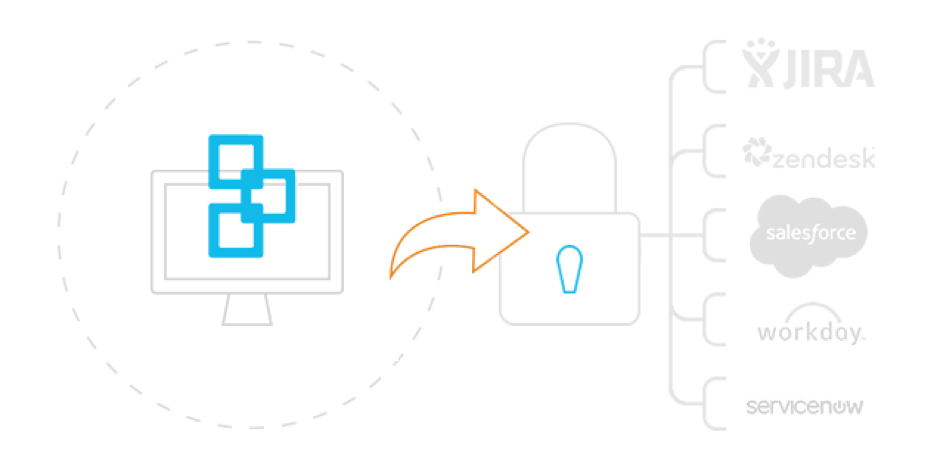
10. Maintaining consistent and up to date documents
One of the core tasks for an Intranet Manager is to maintain consistent and up to date information on the intranet.
If your employees aren’t seeing the latest, final version of a document, you risk a hit to productivity, duplication of effort, frustration and even potentially business-damaging errors, at significant cost.
Business Scenario:
“I used the intranet to find out our preferred supplier before ordering stock. Turns out, the page hasn’t been updated since 2012. I didn’t benefit from the group discount for our most current supplier, and cost our business an additional $15,000 that could have been avoided.”
Quick wins:
- Use version control functionality within your intranet to ensure users are accessing the latest version. You can check when content has been updated and who by; assign sign off responsibility and a dedicated page owner for accountability and audit control.
- Set expiry and review dates for content, alerting you or the dedicated author or page owner when that content needs to be reviewed. In Interact, this is easily viewed and managed from the Analytics function, giving you a complete overview of what needs updating, and who by.
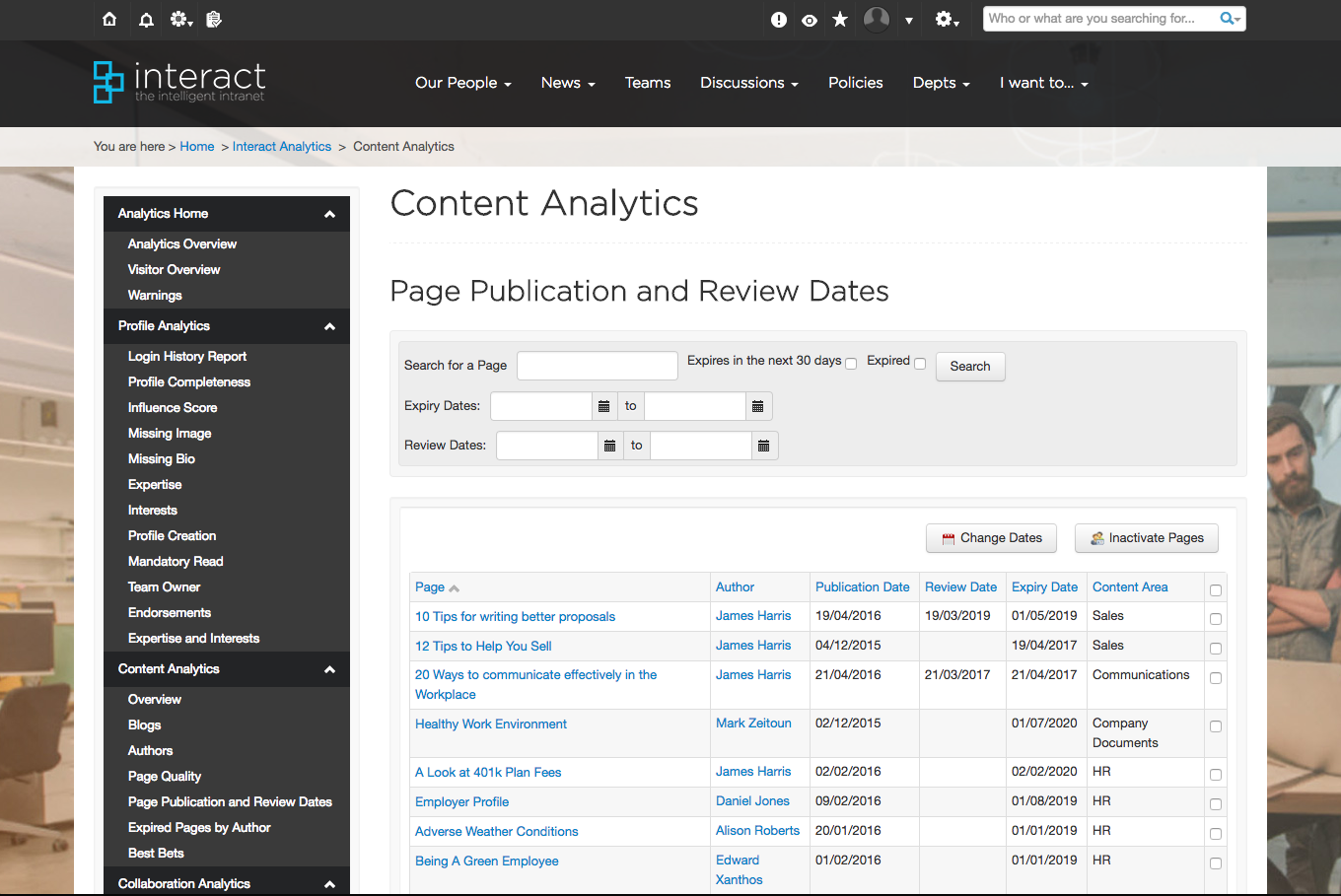
Do you have any other ways to make an intranet managers life easier? Add them in the comments below.




